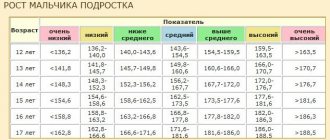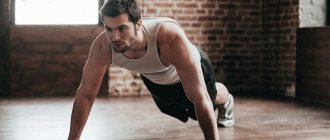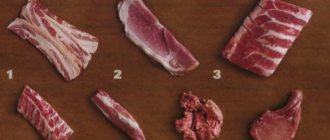Around 1490, the great Italian scientist, artist, and sculptor Leonardo da Vinci drew his famous drawing “The Vitruvian Man.” This design is often used as a symbol of the symmetry of the human body. It depicts the figure of a naked man in two superimposed positions: with arms and legs spread to the sides, inscribed in a circle; with arms apart and legs brought together, inscribed in a square. The drawing and its explanations are sometimes called canonical proportions. The significance of this drawing is difficult to overestimate. After all, proportions are a means of creating a harmonious image not only for architects, artists, designers, but also for clothing designers. Don't know your body type? Take the free test..
How to determine the ideal proportions of a male body
The ideal proportions of a male body are considered to be tall height, a V-shaped torso and compliance with certain parameters, which may differ for men of different ages. Nationality and occupation also leave some imprint on the standard of beauty
At the same time, an athletic figure, broad shoulders and chest, sculpted muscles combined with narrow hips have always attracted the attention of the fair half of humanity
WEIGHT LOSS STORIES OF STARS!
Irina Pegova shocked everyone with her weight loss recipe: “I lost 27 kg and continue to lose weight, I just brew it at night. » Read more >>
The path to an ideal body begins with measuring it. That is, before you change anything about yourself, you need to determine which part of the body requires improvement.
For a more correct result of measurements, they should be carried out in the morning, since after waking up, that is, during the period when rested muscles are relaxed, the body’s indicators will be as accurate as possible. During the day, various loads can greatly distort the data. Only those who, for some reason, experience swelling in the morning can ignore this rule.
The main measurable places of the male body
An ordinary sewing centimeter or tape measure is quite suitable for measuring. If none of the above is at hand, a thread and a ruler will do: grab it with a thread, measure with a ruler.
Below are the basic rules to follow when taking measurements:
| Measuring area | Measuring technique |
| Neck | The head should be kept level. In this position, the transverse line of the neck is measured exactly in the middle |
| Rib cage | Three parameters are measured: in the normal state, at maximum inspiration, and at full exhalation. The centimeter should be placed on the pectoral muscles at the level of the nipples with the arms lowered along the body |
| Waist | The measurement is taken at the narrowest point - approximately where the chest and ribs end |
| Shoulder | The arm bends at the elbow, the biceps and triceps become tense; in this position measure the widest circumference |
| Forearm | The widest area of the forearm is measured |
| Hip | In a calm, standing position, measurements are taken directly under the buttocks. |
| Shin | The calf is measured at its widest point |
Pythagoras was one of the first to become seriously interested in the proportions of the human body, to which he applied his famous rule of the “Golden Section”. According to him, the following ratios can be considered ideal parameters:
- The optimal shoulder width is ¼ of your height.
- The waist should be twice the circumference of the neck.
- The neck circumference should be equal to two wrist circumferences.
- The gap from the crown to the waist should ideally be 1/3 of the height.
- The length of the foot should be equal to the length of the forearm.
The human skeleton is kept in proportions very close to the golden ratio. The closer the physique is to such a ratio, the more correct it is considered to correspond to the ideal of beauty.
Men involved in bodybuilding have several different schemes by which ideal parameters are calculated. Everyone chooses for himself the scheme whose author seems more authoritative to him.
Below are tables that contain information about the proportions of the male body. They are compiled based on observation of athletes over many years.
The values of Marcel Rouet's table are closest to the ancient proportions.
With a height of 165-175 cm, the following parameters are considered ideal:
| Height | Weight | Shoulder | Neck | Rib cage | Waist | Hip | Shin |
| 165 | 65,5 | 35 | 35 | 105 | 75 | 55 | 35 |
| 166 | 65,5 | 35,5 | 35,5 | 106 | 76 | 55,5 | 35,5 |
| 167 | 68,0 | 36 | 36 | 107 | 77 | 56 | 36 |
| 168 | 69,5 | 36,5 | 36,5 | 108 | 78 | 56,5 | 36,5 |
| 169 | 71,0 | 37 | 37 | 109 | 79 | 57 | 37 |
| 170 | 72,5 | 37,5 | 37,5 | 110 | 80 | 57,5 | 37,5 |
| 171 | 74 | 38 | 38 | 111 | 81 | 58 | 38 |
| 172 | 75,5 | 38,5 | 38,5 | 112 | 82 | 58,5 | 38,5 |
| 173 | 77 | 39 | 39 | 113 | 83 | 59 | 39 |
| 174 | 78,5 | 39,5 | 39,5 | 114 | 84 | 59,5 | 39,5 |
| 175 | 80 | 40 | 40 | 115 | 85 | 60 | 40 |
In turn, for a height of 176-185 cm the following measurements will be suitable:
| Height | Weight | Shoulder | Neck | Rib cage | Waist | Hip | Shin |
| 176 | 81,5 | 40,5 | 40,5 | 116 | 86 | 60,5 | 40,5 |
| 177 | 83 | 41 | 41 | 117 | 87 | 61 | 41 |
| 178 | 84,5 | 41,5 | 41,5 | 118 | 83 | 61,5 | 41,5 |
| 179 | 86 | 42 | 42 | 119 | 89 | 62 | 42 |
| 180 | 87,5 | 42,5 | 42,5 | 120 | 90 | 62,5 | 42,5 |
| 181 | 89 | 43 | 43 | 121 | 91 | 63 | 43 |
| 182 | 90,5 | 43,5 | 43,5 | 122 | 92 | 63,5 | 43,5 |
| 183 | 92 | 44 | 44 | 123 | 93 | 64 | 44 |
| 184 | 93,5 | 44,5 | 44,5 | 124 | 94 | 64,5 | 44,5 |
| 185 | 95 | 45 | 45 | 125 | 95 | 65 | 45 |
Joe Weider, a famous bodybuilder and trainer who once trained many famous bodybuilders, compiled his own table of ideal parameters:
Main features of modern standards
Current standards have a direct connection with the ideals of the ancient world. This is a kind of symbiosis of an ancient image and a modern understanding of beauty. Here are the main points of an ideal figure for men:
- Slender, long neck.
- Clear trapezoid lines.
- Relief shoulder muscles.
- Cone-shaped pectoral muscles.
- Relief structure of the abdominal muscles.
- Pronounced back muscles, wide dorsal profile.
- Developed muscles of the lower extremities.
Depending on age, all body proportions will change. The fact is that every year the human body acquires certain physiological changes. Until the age of 25, body height and weight change. A man should begin exercising the muscle component no earlier than 16 years of age. Otherwise, the muscles may become stiff. You shouldn't overload them either. This can lead to the fact that in the future they will not develop and change their volume.
What do average growth rates say?
The conclusion that it is the average population growth that is the most accurate indicator of the health of a nation is, of course, correct, but genetics cannot be discounted. African countries can hardly be classified as economically prosperous, but in the Maasai, Tutsi and Nilotic tribes, men stretch up to 185 cm, or even up to 2 m, while pygmies do not grow above 150 cm.
True, in prosperous Holland, the average height of a man is 188 cm. And the fair sex of this country can hardly be called “inches” - they grow up to 177 cm. In Sweden, Denmark and Norway, these showed only a centimeter less.
The ideal body of a man, according to science
Unlike female canons of beauty, the ideal male figure from the point of view of the ancient Greeks or our contemporaries is practically the same thing. The main thing in a man’s body is a proportional physique, and correcting nature can be done very well in the gym, if only there is a desire. The proportional physique of a man (based on the formulas of McCallum, an American bodybuilder and author of books on bodybuilding) is:
- Chest volume consists of 6.5 wrist volumes
- The volume of the hips is 85% of the volume of the chest
- 34% of the chest volume is the volume of the lower leg
- The waist should be 70% of the chest volume
- Biceps - 36% of chest
- Hip volume - 53%
- Forearms make up 29% of chest volume
- Neck - 37%.
If you carefully compare these parameters with the ancient Greek ones, the same formula of the “golden ratio” can be traced.
Another American bodybuilder, Joe Weider, developed a system of parameters where ideal male proportions are calculated based on the ratio of weight (kg) to height (cm). The weight is not taken as actual, but as ideal, the calculation of which was discussed above. It will help you achieve your ideal weight.
For many years, residents all over the planet have been asking the question: “What are the ideal proportions of a female body?” It turns out that the 90-60-90 we are used to was not always an example of an ideal figure.
Body proportions should not be identical for all individuals of the fair sex, because there are different types of body constitution that Mother Nature has awarded us.
Research has shown that there are three main types of female body:
- Asthenic, that is, thin-boned.
All owners of such a body, as a rule, have elongated legs and arms, a thin neck, and practically no muscle mass. Girls of this body type are not prone to being overweight, they are energetic and very active. - Normosthenic – normoskeletal.
This type is considered as close to ideal as possible, because all parts of the body look proportional and harmonious. - Hypersthenic – large-boned.
Girls of this constitution are characterized by increased transverse dimensions of the body: the shoulders, hip bone and chest have a slightly wide appearance. The skeletal system is thickened and therefore heavy. They often say about such people that they “have a heavy hand,” but this is actually true. Typically, people with this body type have slightly short legs. And they are prone to excess weight.
If you want to know what type you are, quickly find a measuring tape and measure the circumference of your wrist. If your centimeter showed a figure less than 16 cm, then you are classified as asthenic, a figure in the range from 16 to 18.5 cm indicates a normoskeletal type, but if you saw the number 18.5 cm on the measuring tape, then you have become the owner of a hypersthenic type. about physique. Sometimes you can find mixed types of body constitution.
Modern beauty standards
Today the following are considered beautiful:
A powerful V-shaped back that shapes the entire silhouette. Clearly prominent trapezoids and shoulders, as if contrasting with a long, sophisticated neck. Developed, voluminous chest muscles adjacent to dry, clearly visible abdominal muscles. The legs are developed proportionally at the top, not lagging behind in volume, but at the same time not distracting all attention to themselves.
Yes, perhaps this is the ideal figure of a man from the movies.
Exact numbers
To create that same V-shaped silhouette, it is believed that the pelvis and waist circumference should be 10% and 25% less than the chest circumference, respectively, and the neck should be only 38% of the chest.
The thigh circumference is equal to 60% of the pelvic circumference. The lower leg, in turn, makes up only 40% of the pelvic circumference and 60% of the thigh circumference. Another sign of good build is the equality of the shin and tense biceps in volume.
Of course, it’s easy and simple to calculate your ideal proportions, but to make your life easier and not make mistakes, you can use a table of ideal proportions, as well as a variety of calculators that will tell you your ideal proportions using different formulas, reflecting different points of view on the male figure.
All you need to do to use these handy tools is simply measure your height and weight to the nearest centimeter and kilogram and divide the second value by the first. This way you will get a certain coefficient. For example, with a height of 160 and a weight of 80, this coefficient will be 0.5. But remember: a calculator is not the best solution. The ideal proportions calculator is not always accurate.
So what height is considered average for a man?
The height of each of us depends on a combination of 180 genes and, of course, on the lifestyle of the mother who carried the child. And then - and from the lifestyle of the person himself. Once upon a time, the average height of a European man was 160 cm, and our contemporaries reached an average height of 176 cm.
Over time, the concept of what the average height of a man is has changed a lot in the world. Only a teenager can now fit into the knight's armor, which is kept in the museums of Rome. Since the height of these warriors did not exceed 167 cm.
How to take measurements correctly?
The most important thing is that you should adhere to certain rules, which are as follows:
- It is best to take measurements using a regular measuring tape, but a budget option is also possible - thick thread and a regular ruler;
- The most suitable time for measurements is morning, i.e. when the muscles are most relaxed and the body as a whole is “cold”.
Very often, many people say that their numbers fluctuate, this is precisely due to the fact that measurements are taken at different times of the day. Of course, after training, when blood rushes to the muscles, your results may seem simply impressive, but after some time everything returns to normal and the numbers are far from reality.
The measuring tape should not sag or be too tight.
You should not embellish or try to influence the reliability of the data. A very common mistake is wanting to seem better than you really are. And therefore, various tricks are used - drawing in the abdomen when measuring the waist, drawing air into the diaphragm when measuring chest circumference, and so on. Of course, you want to reach the required numbers by any means, not physically, but at least on paper, but be extremely objective about the accuracy of measurements and do not add/subtract extra centimeters.
take measurements in the same places and several times (2-3) for a more accurate assessment.
It often happens that it is necessary to make a series of measurements in order to better ensure the accuracy of the final result. In addition, if you are afraid that you will forget the place from which you took the measurement, then take a closer look at your body and remember (better write down) the characteristic “identifier” of this part of the body. For example, the zone is the forearm, the identifier is a mole on the inside of the arm in the desired measurement location. In general, highlight the characteristic details for each specific area being measured to make it easier to remember where to place the meter next time.
keep a diary of measurements and your personal photo archive-portfolio.
In the latter, enter photographs taken with a camera at the mirror in three angles (front, full face, profile) every 2-3 months. This way you can not only track your progress using dry statistics, but also, most importantly, visually evaluate your result, which will allow you to move forward faster and faster.
Thus, based on all the collected data, you will be able to manage your training process and adjust the program on the go. Yes, at first this process will seem dreary, however, when you get involved and see the first results in the mirror, it will begin to truly motivate you to further move forward towards your goal. Now a few words about how, what and where to measure. For a clear demonstration, I will give the following illustration (see image).
Main measurement locations (see table).
The remaining measuring points look like this.
From the point of view of correct/shaped proportions - the volume of the biceps, neck and calves should be the same, then they say that the person is athletically well built.
Actually, we are done with anthropometry, but there are a number of other indicators that also need to be kept in mind when monitoring achievements. Now we will look at them.
Instructions for taking measurements
In order for the results of measuring body proportions to be as correct as possible, they should be carried out in the morning. The fact is that the body after sleep has the most accurate values. During the day he experiences stress, as a result of which the data may be far from the truth.
Measurements should be taken using an ordinary tape with sections. It will show the most correct results. If you don’t have one on hand, you can use nylon thread and a regular ruler or construction tape.
In order to track changes in the proportionality of body parts, you should keep a diary. It is best to take measurements no more than once a week.
Pay attention to your diet. It should contain as much protein as possible and a minimum of fat. Fast carbohydrates should also be avoided. They break down very quickly and do not bring any results. Try to eat more vegetables and cooked meat. This will allow you to build muscle mass as quickly as possible, and will also increase the productivity of your workouts.
Modern body beauty standards
The standards of a modern man combine the features of an ancient warrior, a young man of the Renaissance and the ideas of modern times.
The typical image of a handsome man is associated with a number of criteria:
- developed V-shaped back, prominent arm muscles;
- long neck, broad shoulders;
- clear waist and elastic abs;
- narrow hip area;
- muscular legs;
- The upper half of the body and the bottom are the same length.
Ideal proportions for athletes
Strength sports require the athlete to have strength, endurance, and developed muscle structure.
A professional level of physical fitness does not involve too much bulk, as in bodybuilding. The athlete must be of strong build and have clearly defined and proportional muscle atlas.
Most guys strive to achieve a pumped up athletic figure. A large back with a clearly defined trapezoidal part, sinewy arms with a sculpted shoulder area, elastic abs and strong legs with pronounced quadriceps and hamstrings are considered indicative.
The standard of beauty for a male model
In the modeling world, there are laws. For a young man to walk along the catwalk, his height must be at least 182 cm.
At the same time, an overly muscular figure is not welcome. Most of all, young guys with clothing sizes 46-48 are in demand. Preference is given to fit guys or even slightly thin guys
Attractive and regular facial features play an important role
Ideal male body proportions for women
Girls are attracted to broad-shouldered young men of medium or tall height, with proportionally developed muscles. However, the requirements for a man's physique are much more varied than the standards of female beauty.
Details are important:
- Strong arms;
- narrow hips;
- sculpted torso;
- piercing look.
For representatives of the fairer sex, male appearance is largely determined by the overall impression and silhouette as a whole. For women, an image that inspires confidence and a sense of security is considered masculine, regardless of the specific indicators of a particular part of the body.
Ideal parameters of a male figure: height, waist, shoulders
There are no generally accepted criteria for appearance. In different nations, due to genetic characteristics, the norms of male body structure will differ. In addition, the indicators of a modern ideal figure and healthy appearance also vary.
Table No. 6 Male physique parameters.
| Data | Standard for men in the Russian Federation (cm) | Collective standard (based on global trends) (cm) |
| Height | 178-180 | 180-185 |
| Waist | 95 | 90 |
| Shoulders | 7.5 cm wider than hips | 10 cm wider than hips |
Is a man’s height a guarantee of his success?
Among our ancestors, a man’s height was directly associated with his health, strength and ability to feed and protect his family, so it is not surprising in the desire of modern ladies to see a tall man next to them. Basic instinct is primarily to blame for this.
And modern tall men, by the way, have not only this advantage. It has been proven that they tend to have a higher average income and move up the career ladder more easily. Scientists associate this with high self-esteem and leadership qualities in such people.
It would seem that representatives of the stronger sex who are large in all respects should have a lot of children. But no! As Dutch scientists have found, the most fertile is a man of average height. By the way, he gets married earlier and has his first child earlier. So, despite the love of beautiful ladies for tall partners, for some reason they start a family with a man of average height. You can't argue with statistics!
Body proportions: it's all in the numbers
So, how attractive this or that person or this or that athlete is depends not on “taste”, but on “numbers”. Well, if we are dealing with numbers (as with a mathematical operator), then the proportions must be described by some specific formula. And it’s called the “golden ratio”. This is a number that describes the entire human body (for example, the length of the arms and legs compared to the torso) and determines which of its proportions are the most correct by nature and look best. For example, the well-known drawing of the Vitruvian man by Leonardo da Vinci (see image) is precisely a demonstration of the triumph of regular geometric forms in the proportions of the human body.
In numbers, the “golden ratio” looks like the ratio “1:1.618”, i.e. if your leg (thigh) is taken as 1, then your leg and lower leg should be 1.618. Due to the fact that a person is a rational being, constantly striving for harmony, balance, symmetry, we judge the beauty of the body by how much the latter differs or does not differ from the ideally symmetrical body, which is described by the “golden ratio”
In relation to fitness/bodybuilding, you should understand that you need to take a comprehensive approach to your body and develop it harmoniously, paying attention to each muscle group. It’s worth saying here that by changing the most noticeable part - your waist-to-shoulder ratio, you will immediately take a significant step towards a harmonious body
Many bodybuilders try, first of all, to optimize as much as possible the “waist-shoulder” ratio of 1:1.618, also called the Adonis index (oh, how much people love all sorts of mythical words :-)).
If you are an ectomorph (thin) body type, then it will be easier for you to pump up your shoulders first, otherwise, start by reducing your waist size first.
To achieve your ideal parameters, you must, first of all, decide on the personal parameters of the “golden ratio”, and then outline a specific plan of action in the form of a correct training program. Now let's take a closer look at what parameters we have at the input, what to do with them and how to calculate our ideal proportions. Because people who come to the gym are all different in their structure and state of physical fitness, so a universal parameter in determining the ideal proportions (what the volume of your muscles should be) can be the largest part of the body, and often this is the pelvis. Therefore, we will build on it.
So, the ideal proportions of your body should satisfy the following ratios”:))90-60-90(applicable only for men, for women everything is the same as before”:
- The pelvic circumference and chest circumference should be 9:10. Those. if your pelvis is 90 cm (in girth), then your chest girth should correspond to 100 cm;
- The neck circumference should be 38% of the chest circumference. If the chest is 100 cm, then the neck is, accordingly, 38 cm;
- the circumference of the forearms should be 30% of the chest circumference; If the chest is 100 cm, then the forearms should be 30 cm.
- waist circumference - 75% of chest circumference;
- hip circumference - 60% of pelvic circumference;
- calf circumference - the circumference of a tense biceps or 40% of the pelvic circumference, or 60% of the thigh circumference.
You can also find out your ideal proportions based on weight and height from the following table (see table).
The “Weight/Height” ratio is the ratio of your weight (in kilograms) to your height (in centimeters). For example, your weight is 70 kg, and your height is 180 cm, which means that the closest value to your coefficient (0.388) is 0.39, therefore, we look at the proportions corresponding to it.
Well, I dug up statistics on the anthropometry of famous athletes, I think you will find it interesting (see table).
So, we have smoothly approached the most interesting (I would even say, the creative process), namely, how to take measurements correctly in order to then calculate the ideal proportions of the body?
The average height of a man is a sign of what?
So, as you probably already understood, the average height of residents of different countries and nations can vary. And this can be facilitated by many factors:
- genetics (for example, Asians are short nations, and Scandinavians have always been tall);
- level of well-being in the state (in successful Japan and China, countries originally inhabited by short residents, height has recently increased by almost 12 cm, and the average Japanese is now almost the same height as an American);
- it is important whether a particular person lives in a city or in a rural area;
- how the mother carried and raised the child;
- Does the person have chronic diseases, which, by the way, can affect growth, taking away an average of up to 3 cm?
A man of average height in different countries can be either 165 cm or 184 cm in height, while being considered among his fellow citizens as a typical representative of the stronger sex who does not particularly stand out in this parameter.
Ideal body proportions
Share this page
Man has always strived for perfection and ideal, to become better, to move forward and develop. This applies to all areas of human activity, be it intellectual abilities or appearance, and we will talk about it in this article.
Over the centuries, ideal ideas about male and female figures have changed several times, but attempts to measure the human body and calculate its proportions have been made constantly. At all times, a man had the image of a strong, muscular and hardy person, this is eloquently demonstrated by ancient statues. Already in those days, athleticism was quite well developed and competitions were held in physical strength and dexterity.
The concept of ideal today
If we take ancient statues, their sizes are closer to natural parameters, which is explained by the rule of the “Golden Section”, derived by the ancient scientist Pythagoras. And, based on it, perfection should be determined by the following proportions for both sexes:
- waist size should be twice the neck circumference;
- in turn, the neck is twice the circumference of the wrist;
- shoulder width should not exceed 1/4 of a person’s height;
- The size of the forearm and foot (their length) should ideally be equal.
If something doesn’t add up, it means the figure is not perfect. But seriously, since every person is unique, we shouldn't be so strict about perfection.
Important indicators of a perfect body today are: age, height and wrist circumference. Essentially, this is a measurement of the bones, which determines the light, heavy and medium type of build.
- Thin-boned type – 14.5 cm in women, 18 cm in men;
- The average constitution is 15-18 cm for women, 18-20 cm for men;
- Heavy type - 18.5-20.5 cm in women, more than 20 cm in men.
To calculate the optimal weight for a woman, you should use the formula: for a man, subtract 100 from your height in cm and multiply this number by 0.85.
Women also need to subtract 100 from their height, and then multiply the resulting figure by 0.9.
| Weight height | Neck | Biceps | Forearm | Breast | Waist | Pelvis | Hip | Shin |
| 0,34 | 35,6 | 33,3 | 27,7 | 92,5 | 69,3 | 83,3 | 50,0 | 33,3 |
| 0,36 | 36,8 | 34,5 | 28,7 | 96,3 | 72,1 | 86,6 | 51,8 | 34,5 |
| 0,39 | 38,1 | 35,8 | 30,0 | 99,8 | 74,7 | 89,7 | 53,8 | 35,8 |
| 0,42 | 39,6 | 37,1 | 31,0 | 103,4 | 76,2 | 93,0 | 55,9 | 37,1 |
| 0,44 | 40,9 | 38,4 | 32,0 | 106,9 | 80,3 | 96,3 | 57,7 | 38,4 |
| 0,47 | 42,4 | 39,9 | 33,3 | 110,5 | 82,8 | 99,6 | 59,7 | 39,9 |
| 0,50 | 43,7 | 41,1 | 34,3 | 114,3 | 85,6 | 102,9 | 61,7 | 41,1 |
| 0,53 | 45,2 | 42,4 | 35,3 | 117,9 | 88,4 | 105,9 | 63,5 | 42,4 |
| 0,57 | 46,5 | 43,9 | 36,6 | 121,9 | 91,4 | 109,7 | 65,8 | 43,9 |
| 0,60 | 47,8 | 45,2 | 37,6 | 125,5 | 94,2 | 113,0 | 67,8 | 45,2 |
Based on the tabular indicators, it should be taken into account that the coefficient of weight and height is found by dividing these two parameters. For an athlete weighing 100 kilograms and height 180 cm, it is 0.555.
| Height, cm | Weight, kg | Neck, cm | Biceps, cm | Chest, cm | Waist, cm | Hip, cm | Shin, cm |
| 165 | 65,0 | 35,0 | 35,0 | 105 | 75 | 55,0 | 35 |
| 166 | 66,5 | 35,5 | 35,5 | 106 | 76 | 55,5 | 35,5 |
| 167 | 68,0 | 36,0 | 36,0 | 107 | 77 | 56,0 | 36,0 |
| 168 | 69,5 | 36,5 | 36,5 | 108 | 78 | 56,5 | 36,5 |
| 169 | 71,0 | 37,0 | 37,0 | 109 | 79 | 57,0 | 37,0 |
| 170 | 72,5 | 37,5 | 37,5 | 110 | 80 | 57,5 | 37,5 |
| 171 | 74,0 | 38,0 | 38,0 | 111 | 81 | 58,0 | 38,0 |
| 172 | 75,5 | 38,5 | 38,5 | 112 | 82 | 58,5 | 38,5 |
| 173 | 77,0 | 39,0 | 39,0 | 113 | 83 | 59,0 | 39,0 |
| 174 | 78,5 | 39,5 | 39,5 | 114 | 84 | 59,5 | 39,5 |
| 175 | 80,0 | 40,0 | 40,0 | 115 | 85 | 60,0 | 40,0 |
| 176 | 81,5 | 40,5 | 40,5 | 116 | 86 | 60,5 | 40,5 |
| 177 | 83,0 | 41,0 | 41,0 | 117 | 87 | 61,0 | 41,0 |
| 178 | 84,5 | 41,5 | 41,5 | 118 | 88 | 61,5 | 41,5 |
| 179 | 86,0 | 42,0 | 42,0 | 119 | 89 | 62,0 | 42,0 |
| 180 | 87,5 | 42,5 | 42,5 | 120 | 90 | 62,5 | 42,5 |
| 181 | 89,0 | 43,0 | 43,0 | 121 | 91 | 63,0 | 43,0 |
| 182 | 90,5 | 43,5 | 43,5 | 122 | 92 | 63,5 | 43,5 |
| 183 | 92,0 | 44,0 | 44,0 | 123 | 93 | 64,0 | 44,0 |
| 184 | 93,5 | 44,5 | 44,5 | 124 | 94 | 64,5 | 44,5 |
| 185 | 95,0 | 45,0 | 45,0 | 125 | 95 | 65,0 | 45,0 |
To check how important proportions are for professional athletes, you can compare the body measurements of the best bodybuilders against tabular data that demonstrates ideal girth sizes.
Knowing exactly what proportions in bodybuilding are taken as ideal, each athlete has a chance to measure and compare their own parameters with them.
Body proportionality, as has already become clear, is crucial for a professional bodybuilder. Whether an amateur should strive for such an ideal is a separate topic that requires more detailed consideration.
Professionals bring their body proportions to ideal levels through the use of pharmacological drugs. In amateur bodybuilding, everything depends on genetics. Small shoulders and a narrow back cannot be greatly expanded without serious sports pharmacology. This also applies to the chest. It will not become much larger if there is no such predisposition.
If measurements show that the proportions do not correspond to ideal ones, you should not be upset. Achieving perfection is necessary only for those who strive to perform and win competitions. For amateur bodybuilding, perseverance and training are important, allowing you to improve your natural abilities in order to feel great on the beach or in the pool, and increase self-esteem.
How to take measurements
This example is on the biceps
Typically, body measurements are taken with a measuring tape. It is located parallel to the axis of the bone. The centimeter should fit as closely as possible to the skin, without compressing it. There are no specific rules for this procedure and there is no universal way to carry it out either.
It is better if the person does this not to himself, but to his relatives and friends, this will increase the accuracy. But if this is not possible, then you can handle it yourself. Measurements are taken in the morning on an empty stomach. It's always better at the same time.
This will reduce the possibility of error. There have been cases where athletes have complained about large jumps in volume, but they simply measured their body at the wrong time of day every time. It makes no sense for girls to measure this part, unless there are large changes in weight. That's why they measure once.
To carry out the most accurate measurements, you need to bend your arm at the elbow at an angle of 90 degrees, clench your hand into a fist, and turn it towards your forearm at the same angle. External and internal muscles are extremely tense.
Measurements should be taken at the widest part of the forearm, 1-2 cm from the beginning of the shoulder. As mentioned above, ideally for male bodybuilders, the forearm circumference is 30% of the chest circumference. For example: the chest is 100 cm, then the forearm is 30 cm. With this proportion they will correspond to sports standards.
Calculating ideal proportions based on chest circumference
Even in my youth I heard the word “torsist”. This was the name given to bodybuilders with weak legs - those who really did not like to train their legs.
You can determine the lag by eye, but if you use the same Weider table, you will notice that the thigh circumference is 1.5 times larger than the biceps circumference.
If a person, after rapid weight loss, has a thigh circumference that is 1.7 times larger than his biceps, then this looks unusual. The same proportions can be observed in football players or weightlifters.
Of course, it also happens that a person is born with a narrow wrist and a wide ankle. In such people, legs are dominant in their physique from birth.
It happens on the contrary that a person has wide wrists and narrow ankles. These are born torsists.
Often such genetic features are associated with origin: the descendants of infantrymen have thick ankles, and the descendants of horsemen have thin ankles. But on average, the streams of infantrymen crossed with the descendants of horsemen many times, so for the most part we are all normal people and deserve normal proportions.
My research into the results of athletic competitions over the past 45 years has proven that it is not always the athlete with the largest muscles and body circumferences who wins the highest titles; 47.5 cm arms and a 125 cm chest alone do not warrant a world class title unless these Herculean parameters are accompanied by proportionate sizes of other parts of the body.
Europeans' height increased by 11 cm
What exactly affects the number of centimeters from the top to the heels of each person? Data on the dependence of growth rates on race is no secret. Asians are short people. Their height is on average 165 cm, and Europeans grow up to 178 cm.
But it is not only genetic inheritance that predetermines these parameters. In prosperous countries, people are taller than in countries where the economy is miserable. After all, the quality of the foods eaten, their variety, and the absence of the need to work hard, along with developed healthcare, help a person become taller. This is probably why, until recently, the average height of an American man was the largest in the world.
According to the observations of researchers, the body length of the average man has increased by 11 cm since the end of the 19th century - from 167 cm to 178 cm.











